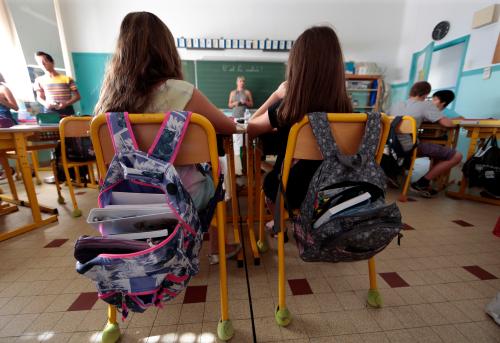This piece was originally published by EdSurge.
I recently moved a drone with my mind. Not long ago my 6-year-old son spent two hours on my bed swishing through the world’s biggest roller coasters on YouTube with cardboard virtual reality glasses. My mind-control-drone-moving experience was nothing like this.
I stood facing the drone, about to face off with a little robot. Time to figure out who is boss. I silently sent authoritative thoughts toward the drone, a cute black wire sphere the size of my two hands, resting on a white platform at waist height. I had on an electronic headband, which kept slipping down the back of my head. Apparently, my powers over the drone could not be brought into full force with the band dropping past my brainwaves. After several adjustments, I was ready.
“Relax your mind,” said a young man standing next to me. He held in his hand a tablet and I watched as it recorded my brainwaves. “Now, pick a word and focus on it, this will be the word you use to make the drone fly,” he said. I chose, “up,” but “cheese” or “pajamas” would have worked equally well. As I repeated “up, up, up” in my mind, I watched the tablet map my thoughts, converting my brainwaves into an algorithm. With the tap of a button the young man sent my “up” algorithm to the drone. “OK” he said, “clear your mind and give it a go.”
The experience was uncannily reminiscent of Jedi training. And like Luke in his first lesson, I was a total flop at first. I thought “up, up, up” as hard as I could and fixed a penetrating stare at the drone but it didn’t move.
“It’s a lot of pressure. Take a deep breath and try again,” said the young man, encouraging me in true Yoda fashion. “UP, UP, UP,” I thought, fixing my mind on the drove. And, amazingly, up it went. Hovering here and there and lurching around a bit, but most certainly skyward. After 30 seconds of amazing drone control, I’d had enough. I stopped repeating “up” but the drone kept flying. “Close your eyes” said the young man. I did and the drone immediately fell to the table.
Afterward, one thing struck me. The future belongs not just to those who can write algorithms but to those who can control their thoughts.
The drone was part of a demonstration of the powerful technology that the neuroinfomatics company EMOTIV offered at a conference on the power of technology and education. The company is one of a number of organizations that have been working on ways for people to control everyday objects with their minds, including cars.
But this is just the tip of the iceberg, Olivier Oullier, president of EMOTIV, told me when I asked him about his company. Olivier, a top neuroscientist with hundreds of academic publications to his name, says that in the future we will no longer have to rely on the wishy-washy, inexact social sciences to figure out what people think. Soon we will have no use for interviews, focus groups, or surveys—the typical go-to tools for understanding what people think and feel. We will look right inside people’s minds.
Indeed, EMOTIV is taking mind-control to retail markets. For a mere $300 you can purchase the electronic headband and for $800, a version that will enable real-time brain mapping. The company touts the many uses of this equipment, from workplace effectiveness to understanding exactly what consumers want (the latter apparently is where they plan to cash in, with companies that will pay top dollar for this information).
If I really want to help my children be prepared for the future, I should enroll them in meditation classes. They may or may not become data scientists, but they will surely in their adult life have to interface with machines by using their minds. And perhaps more importantly, they will need to learn to control their thoughts amid an increasingly brain-transparent world.
Mindful Thought Control
Controlling your thoughts is hard—witness my pitiful first attempt. Scientists first learning to drive a car with their minds in a project called the Brain Driver recount taking months to figure out how to focus the mind so the car could pick up simple directions like right, left, and straight.
As adults, will today’s children live in a world where she who can quickly and nimbly control her thoughts is the one who gets ahead? And, equally important to ponder, will they live in a world where workplace human resources departments give trainings not only on how to behave appropriately, but how to stop inappropriate thoughts?
There is increasing interest in the role of meditation and mindfulness training in education. When I asked David Pearson, a British clinical psychologist who works with children facing adversity, if regular mindfulness practice would have helped me fly my drone his answer was “Yes, it would.” He explained that one important principle in mindfulness training is to practice being fully present. Not worrying about the future or rehashing the past but simply focusing on the here and now is an important element across various psychotherapy approaches, and this ability can help people focus the mind on a range of tasks they need to do to get through the day, including potentially mental-drone flying.
Currently, much of the discussion within the education community focuses on the role that mindfulness practices can have in improving outcomes at school. Over the past two decades, multiple studies have demonstrated that schools adopting mindfulness training—including things like weekly meditation practice in their schedule—see reduced disciplinary incidents, improved attendance, and increased prosocial behavior.
This idea of mindfulness training as a means to improve school culture has recently gained traction in the media. In the United States, for example, news outlets from The Washington Post to CBS have reported on Baltimore’s experience. In the city, one of the most violent in America, the Holistic Life Foundation worked with more than 21 elementary and high schools in the area in 2018 to implement its Mindful Moment Program, which combines meditation and yoga to promote self-regulation. The program’s results are promising thus far: Schools in the program have seen reduced suspension rates, increased test scores, and greater promotion rates.
Across the pond, U.K. schools have been exploring similar opportunities. Following the promising results of such programs as the Mindfulness in Schools Project, research institutions across the U.K. launched a seven-year, 6,000-student randomized control trial in 2015 to assess the impact of school-based mindfulness classes on children’s mental health.
I spoke with Will Williams, one of London’s meditation gurus. “Kids get it right away,” he said explaining that they are often easier to teach than adults because they are more open. He sees great promise in helping our current social institutions, from schools to juvenile justice programs, improve their outcomes by helping young people learn to meditate.
But perhaps one of the most important, although under-discussed, benefits of scaling up meditation and mindfulness throughout schools is that it can help provide the basis for the ultimate 21st-century skill: the ability to focus the mind. Many education policy discussions focus on the importance of giving children skills including digital literacy, coding, team work, critical thinking, and problem solving. All important. But helping children develop the ability to quiet the mind, control their emotions, focus their thoughts, and self-regulate could increasingly gain prominence in education curricula of the future.
Underscoring what child development psychologists have long known, there is a growing movement in education to attend to social emotional learning and there is a growing body of evidence specifically around how meditation and mindfulness help improve things like children’s attention and ability to deal with adversity.
Over the last several years, I have been researching education innovations and thinking about what it would take to leapfrog—in other words to make much more rapid education progress. The first question I asked myself was where should the education community try to be leapfrogging to? I quickly settled on the idea that our aspirations for what education should help young people know and do should be equally high for all children, poor and rich alike.
The best schools in the world are helping children develop a breadth of skills and competencies from empathy to collaborative problem-solving all the while being rigorously trained in academic subjects. They largely do this not by adding new subjects to the school timetable but by harnessing innovative pedagogies to teach existing subjects. Helping all children develop this broad suite of capabilities is to me the real purpose behind pursuing leapfrog strategies.
After learning to control a drone with my mind, it was clear that mindfulness and meditation are important approaches that deserve a more prominent role. To truly help young people learn, those of us in education need to increasingly lift up our heads and examine the world around us, and the world that is coming.






Commentary
I moved a drone with my mind. Soon your students will too.
March 8, 2019